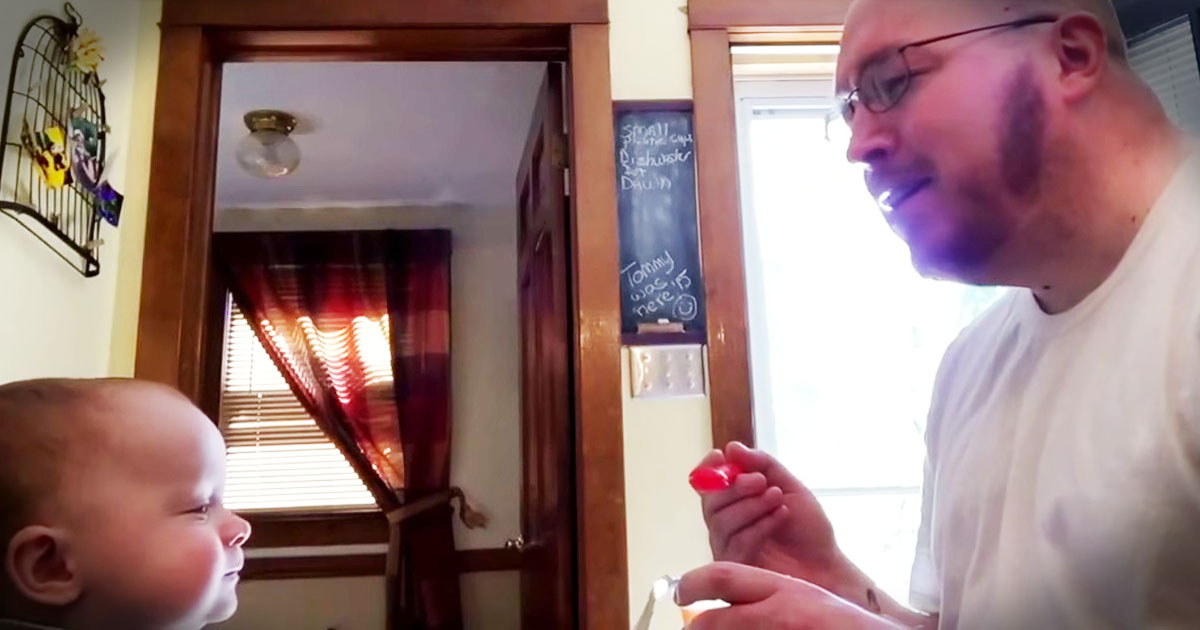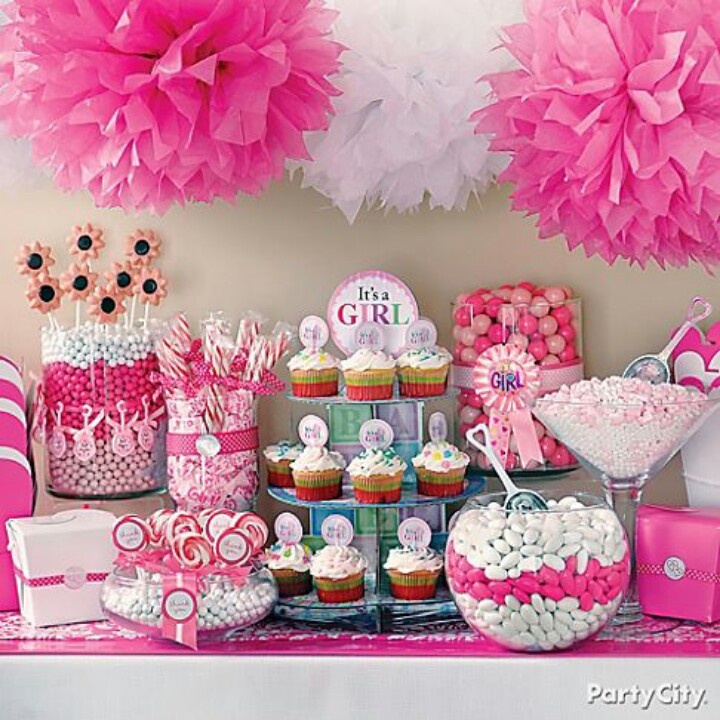Small freezer containers for baby food
Buying Guide 2022: Best Baby Food Storage (6 expert tips)
The Best Baby Food Storage Containers for storing and freezing homemade baby food. Plus – 6 expert tips on how to store baby food, as well as a how-to guide on freezing and thawing your own baby food, FAQs, pros and cons and so much more!
Medically reviewed and co-written by Lauren Braaten, Pediatric Occupational Therapist (OT).
Best Baby Food Storage ContainersWant to make your own homemade baby food, but are not sure the best way to store it?
Then this post is for you!
Regardless if you are making homemade purees or going with the baby-led weaning approach to feeding your baby, you will need some small fridge and freezer-safe containers to store your baby’s food in.
Below you will find my tried-and-true storage containers at all price points, along with my guide on how to freeze and thaw baby food purees., FAQs, pros and cons of each container, as well as 6 tips on the best way to store baby food.
How to Make Baby Food Video
Watch this video to see how easy it is to make and store your own baby food!
Top Baby Food Freezer Storage ContainersIf you just want to cut straight to the chase – these are our absolute favorite storage containers for baby food.
Baby Food TraysWEESPROUT Silicone Baby Food Freezer Tray – great 10-sectioned baby food tray that holds 1.5oz each, but has a 1 oz fill line for smaller portions. Is made out of premium food-grade silicone and has a plastic lid for easy stacking. These trays or worth their price and we would recommend getting a couple of their fun color trays so you can easily stock up on your homemade baby food.
4 Pack of Silicone Ice Cube Molds Tray with Lid – This is a newer purchase for us and so far the quality has been great and you can’t beat the price for 4 trays! The trays are made out of food-grade silicone and BPA-free plastic and each cube gives you 1oz of baby food.
WEESPROUT Glass Baby Food Storage Containers – We absolutely love these jars! You get 12 colorful glass jars that hold 4oz each. Great for storing baby food purees as well as yogurts, overnight oats, chia seed pudding for toddlers and kids. While the price is a little high, you will get many years worth out of these jars. Well worth the investment in our opinion.
Babymoov Glass Food Storage Containers – I love that this set comes with two different sizes of containers – 4oz and 8oz. This is great if you have a baby that is a bigger eater and needs more than an ounce or two of purees at each meal.
Plastic Baby Food ContainersWEESPROUT Leakproof Baby Food Storage – just as amazing as their glass jars, just with a smaller price tag! This set comes with 12 colorful 4oz jars made out of BPA free high-quality polypropylene plastic. I also love that this plastic version is easier (and lighter) to toss into your diaper bag for a quick baby meal on the run.
I also love that this plastic version is easier (and lighter) to toss into your diaper bag for a quick baby meal on the run.
OXO Tot Baby Blocks Freezer Storage Containers – a great smaller set that contains 4 – 4oz PVC, BPA, and phthalate-free jars and a storage tray. Great space-saver system that helps keep your jars of baby purees organized and tidy. Plus, you can easily stack more trays on top of each other if you need a bigger freezer stash.
Full Review of each Container: for our full reviews on each of the above products, including pros and cons, go to the end of this guide.
Other Helpful Tools- Stasher Bags – these silicone reusable bags can hold your frozen cubes of baby food purees.
- ZipLock Bags – another option for storing your frozen purees in.
When making homemade baby food purees, your freezer is about to become your best friend, allowing you to keep several weeks’ worth of baby purees at the ready.
For more information on how to make your own baby food, check out my Ultimate Guide on Making Your Own Baby Food!
- After making your puree, let it cool until just warm.
- Spoon the puree into your choice of baby food storage container.
- Cover your container with a lid or plastic wrap, and place in the freezer.
- Let the puree freeze completely before you crack the purees out of the tray and place the cubes into a plastic freezer zip-lock or stasher bag. If using jars, the frozen purees would stay in the jars.
- Label each bag or jar with the name of the puree and the date you made it.
Thawing may seem like a no-brainer, but it never hurts to know your options. There are three different ways to thaw purees:
MicrowaveTake the frozen puree cubes that you want to serve out of your freezer, place them in a glass container, and microwave in 20-second increments, stirring every time. The puree is ready when it is just warm to your touch.
The puree is ready when it is just warm to your touch.
Grab two clean spoons, one for you and one for your baby, and test your puree before serving.
Some infants like their puree cold, warm, or really warm, and some will devour it no matter the temperature. You will get to know your baby’s personal preferences as the two of you bond over food.
FridgeThis one takes the longest time, but it is a great alternative to using a microwave.
Take the frozen puree cubes you want to serve out of your freezer, and place them in glass containers with airtight lids and leave in the fridge for 12 to 16 hours. Do not leave the puree in the container to thaw on the counter or anywhere out of the fridge, as bacteria will start to grow at a rapid rate – which is definitely not good.
The puree will be cold but thawed, so if your baby likes her puree warmed, you’ll have to finish the job using the microwave or stovetop method.
StovetopIn the smallest saucepan, you can find, place the frozen puree cubes you want to serve, and gently thaw them on medium-low heat until warm, stirring occasionally.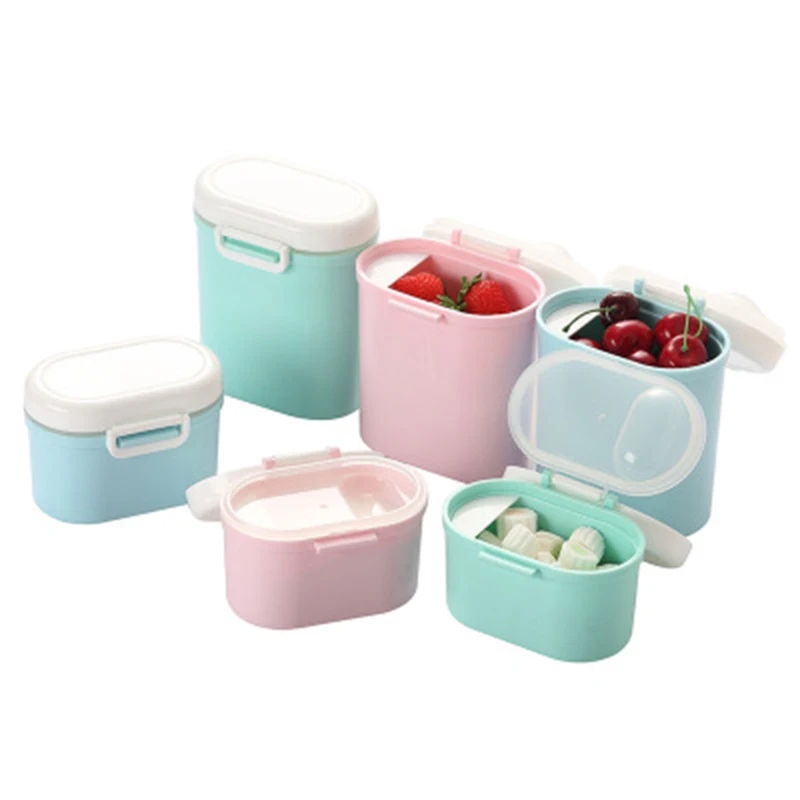
Frequently Asked Questions
How long can you store homemade baby food?
You can store homemade purees in the fridge for up to 5 days or up to 4 months in the freezer. For small finger foods, depending on the item, you can store those in the fridge for 2-3 days.
Is it better to store baby food in glass or plastic?
You can do either! Just make sure to use plastic containers that are BPA-free and container no scratches or dents. To keep the plastic in tact, be sure to wash the containers by hand and do not place in the microwave.
6 Expert Tips on Storing Baby Food- Do Not Overfill: it’s important not to overfill any baby food storage container as the purees will expand slightly when freezing.
- Label Purees: in order to know what you are feeding baby, it’s important to label your purees while they are freezing in the storage containers and when they are stored in freezer bags.
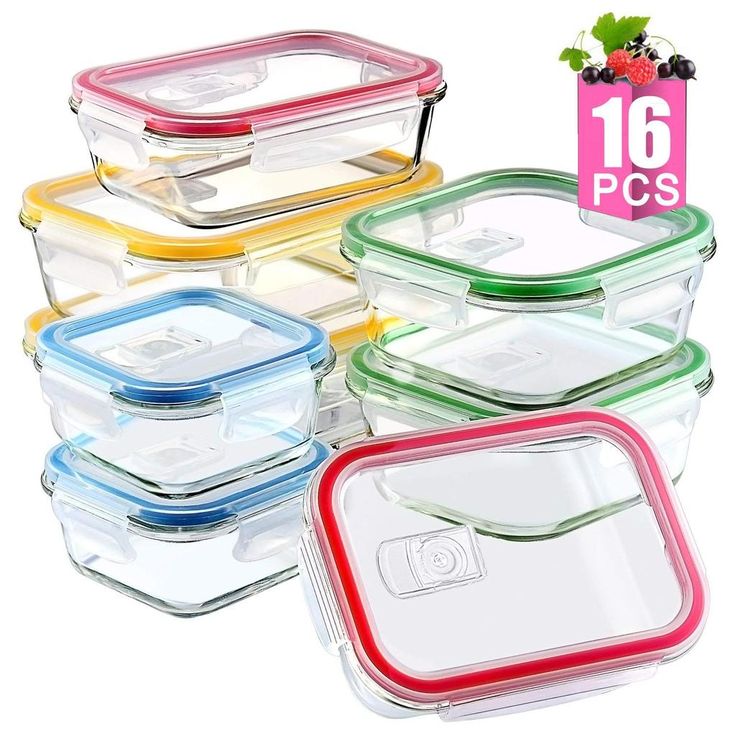 Make sure you put the name of the puree as well as the date you made it on. Putting the date on it helps you remember when the puree will expire.
Make sure you put the name of the puree as well as the date you made it on. Putting the date on it helps you remember when the puree will expire. - Keep Some/Freeze Some: whenever you make a puree, put several ounces in the fridge for your little one to enjoy that week, then freeze the rest of the batch for her to finish up at a later date.
- Dedicate Space in Freezer: I found it helpful to dedicate a certain space in the freezer (a shelf or drawer) just for your homemade baby food purees. That way you don’t have to go rummaging around your freezer trying to find a puree when your baby is already hungry for dinner. I also found this helpful so that I could take a quick look in my freezer to know exactly how much purees we had on hand and when I would need to make some more.
- Have Multiple Storage Containers on Hand: while not cheap, having multiple storage containers on hand is really needed to be able to have a good freezer stash of your own baby food.
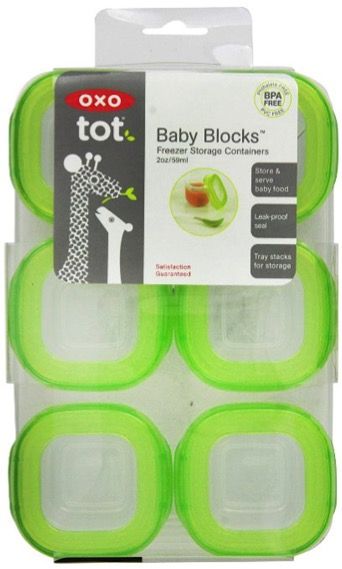 I usually recommend having at least 4 storage trays or 2 sets of jars. This way you can make and store a good amount of purees for the weeks ahead. With the trays, you will freeze the purees in them and then once frozen you can pop out the cubes and place them into a freezer bag, thus leaving you with more trays to work with. For the baby food jars, you will freeze the purees in the jars but they do not pop out, you have to thaw and serve the purees in order to get the jar ready for the next round of food. Either work great, just depends on how you work in your kitchen.
I usually recommend having at least 4 storage trays or 2 sets of jars. This way you can make and store a good amount of purees for the weeks ahead. With the trays, you will freeze the purees in them and then once frozen you can pop out the cubes and place them into a freezer bag, thus leaving you with more trays to work with. For the baby food jars, you will freeze the purees in the jars but they do not pop out, you have to thaw and serve the purees in order to get the jar ready for the next round of food. Either work great, just depends on how you work in your kitchen. - What to Look For: regardless of which jars or trays you go with, look for a freezer-safe and dish-washer-safe brand, cuz I know you have better things to do than handwash dishes!
More Resources
Here are some more in-depth guides that will help you feed your baby!
- Best Spoons for Baby
- 12 Best High Chairs for Baby
- Best Sippy Cups for Baby
- Best Baby Cereals
- Beaba Babycook Neo Review
Key Features
- Includes 10 sections that hold 1.
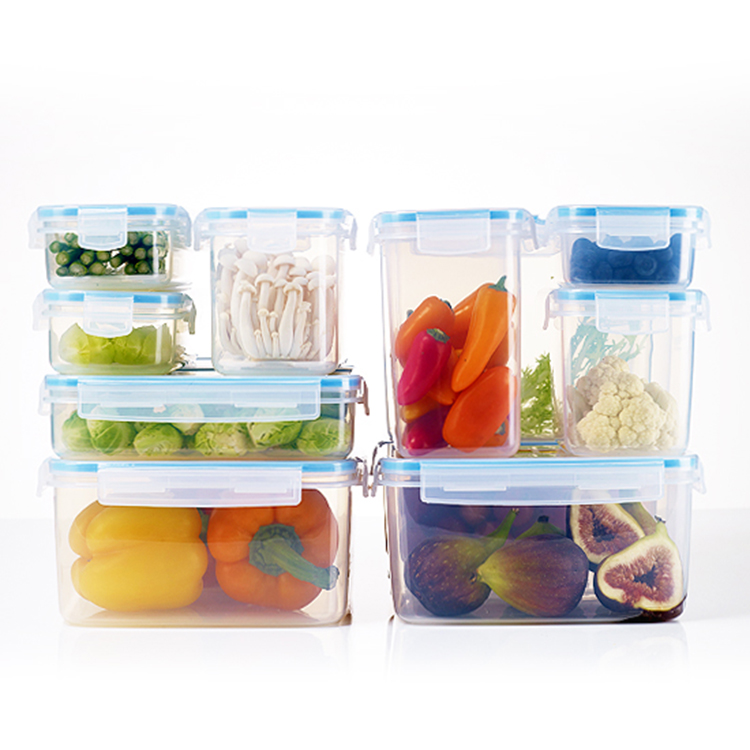 5 ounce each, with a 1-ounce fill line for smaller portions
5 ounce each, with a 1-ounce fill line for smaller portions - 100% food-grade silicone
- Reinforced bottom with a sturdy build for stacking multiple trays
- Non-stick for easy food removal
- Easy clip-on lid provides coverage
- Dishwasher safe
- Available in a variety of fun colors
Why Our Experts Love it
No more time spent looking for lost container lids! We love this compact, all-in-one baby food storage design. It’s ultra-durable, unbreakable, and made with 100% food-grade silicone, which means no harmful chemicals contacting your baby’s food.
Pros/Cons
Pros
- Multiple sections make it possible to mix and match flavors for a balanced meal
- 100% food-grade silicone
- Sturdy design makes it easy to stack multiple trays at once
- Comes with easy clip-on lid
- Dishwasher safe
Cons
- Lid is made of plastic, although contact with baby food is minimal to none, depending on how full you decide to fill containers
Parent’s Review
WEESPROUT Silicone Baby Food Freezer TrayI’m really pleased with the baby food cube trays.
-JenniI’ve now been using them for 2 weeks to do my batch cooking for my baby boy. They’re fantastic, good portion sizes, easy to remove and clean, great clip-on lid to prevent food from spilling out before frozen. I will most likely invest in a couple more trays in the near future.
No more making baby food every day or cleaning multiple containers throughout the week! Batch prep baby food, purees, breastmilk, and more – then store your food in the tray or transfer to a Ziploc bag for easy meals.
Amazon
Walmart
Key Features
- Food grade silicone
- Comes with removeable lid
- Easy to stack and store in the freezer
- Dishwasher safe
Why Our Experts Love it
The quality is great and you can’t beat the price for 4 trays! Each cube gives you 1 ounce of baby food for perfect portion sizing to help minimize waste.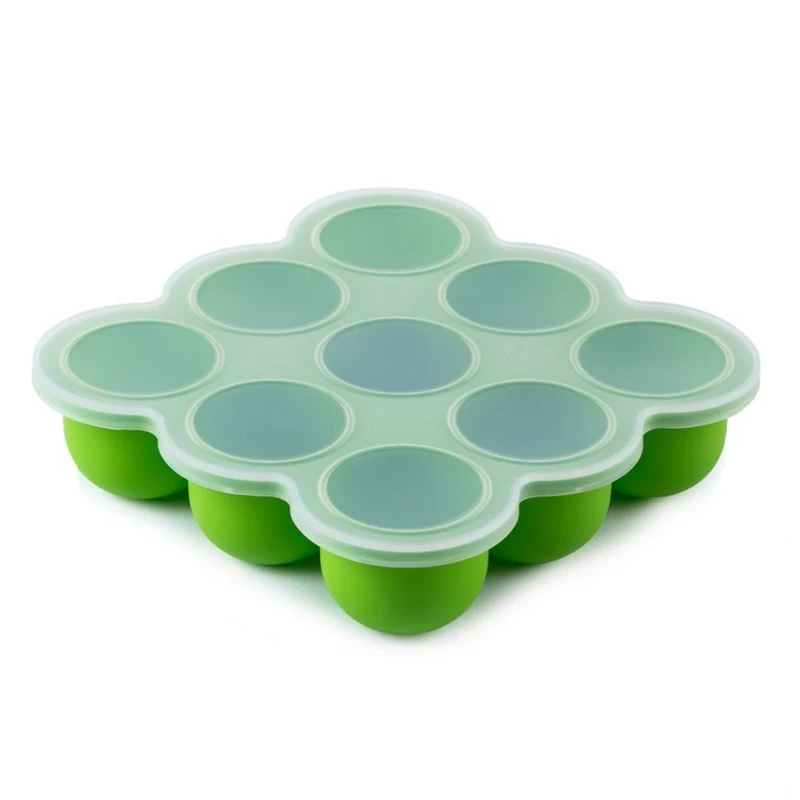
Pros/Cons
Pros
- Great price
- Each tray has 14 small sections, giving you plenty of space for different baby food flavor combinations
- Small portion size can be useful for other items, such has freezing bone broth, fresh herbs in olive oil or candy molds
Cons
- Not made with the same high-qualilty materials as the trays marketed for baby food – which may not last as long.
Parent’s Review
4 Pack of Silicone Ice Cube Molds Tray with LidI bought the trays to freeze my homemade baby food (thanks to COVID-19, I needed to save money and had the extra time). These trays are AMAZING! The lids made for easy stacking in the freezer. The cubes were very easy to pop out, definitely more sturdy than they feel, easy to clean, great colors, and can’t beat the price for he quality. I highly recommend this product!! Thank you!!
-Lacey
These silicone ice cube molds are quite the bargain! The flexible silicone material shapes the bottom well, making it easy to release baby food.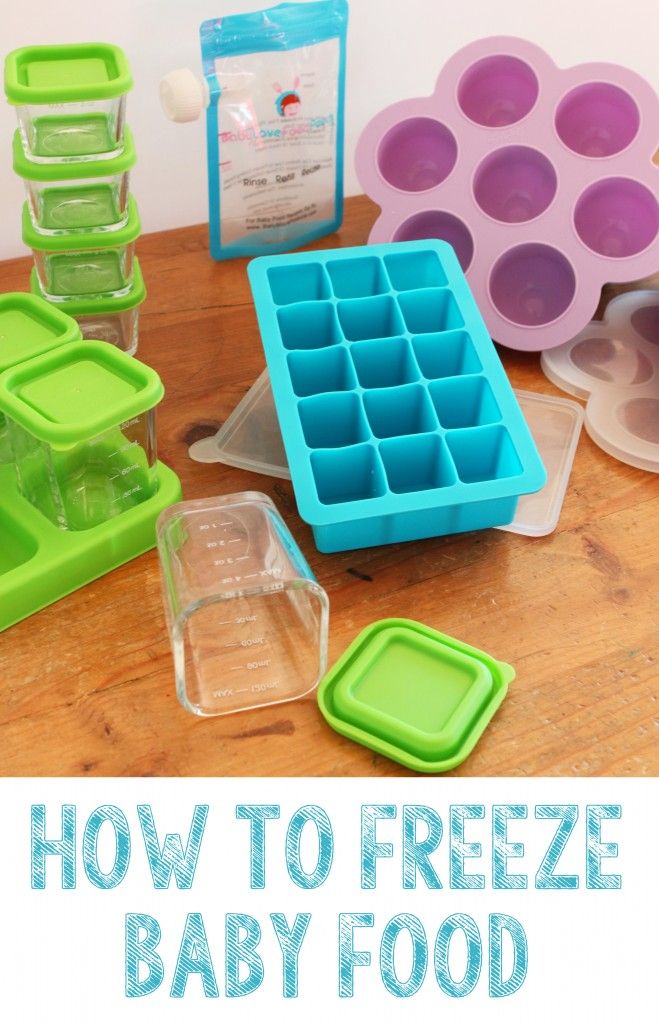
Amazon
Key Features
- Set of 12 glass baby food storage containers with lids
- 4-ounce capacity jars with measurement markings
- Made of food-grade glass
- Airtight, twist-on lids
- Microwave, freezer and dishwasher friendly
- Also available in 8-ounce capacity
Why Our Experts Love it
We love these colorful, eco-friendly glass jars. They are great for storing baby food purees as well as yogurts, overnight oats, and chia seed pudding for toddlers and kids. They also come in a BPA-Free plastic version – WEESPROUT Leakproof Baby Food Storage.
Pros/Cons
Pros
- Ultra-durable glass jars
- Airtight twist-on lids helps keep food fresh
- Convenient measurement markings lets you control the portion size
- Jars are stackable for space saving
Cons
- More expensive than other storage containers, although many reviewers feel their durability makes the investment well worth it
Parent’s Review
WeeSprout Glass Baby Food Storage ContainersI’m thrilled at this product.
-MichelleI was looking for non-toxic, non-plastic container options to store baby food and to take to daycare. This has been an awesome solution! I love that I can store in freezer, write on lid, and thaw food in warmer without worrying about heating up plastic. The glass is sturdy, they look great, and I can reuse for more than just baby food. I’m really happy with this purchase. The package came safe with thoughtful minimal packaging. Love this eco-friendly, zero waste baby product. Wee Sprout has been excellent to work with and offers amazing customer service.
WeeSprout Baby Food Storage Containers make batch preparing baby food quick and easy. Airtight lids keep food fresh, nutritious, and delicious longer.
Amazon
Walmart
Key Features
- Set of 8 glass containers and lids (four, 4 ounce and four, 8 ounce containers)
- Measurement markings on the jars
- Leak proof lids
- Made of environmentally-friendly glass, BPA and Phtalate free
- Microwave, freezer and dishwasher safe
Why Our Experts Love it
We love that this set comes with two different sizes of containers – 4 ounce and 8 ounce.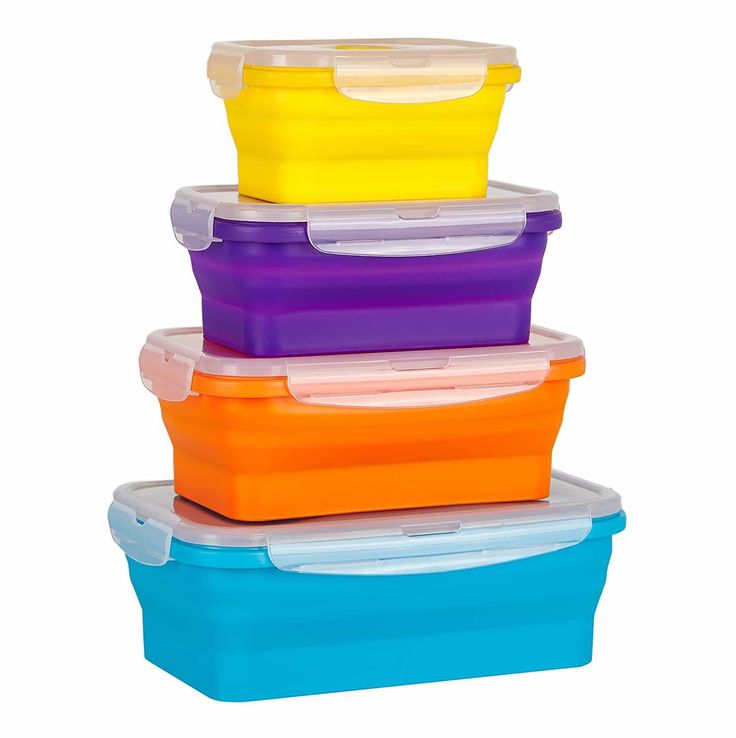 This is great if you have a baby that is a bigger eater and needs more than an ounce or two of purees at each meal.
This is great if you have a baby that is a bigger eater and needs more than an ounce or two of purees at each meal.
Pros/Cons
Pros
- Multi size pack provides convenience
- Airtight screw top keeps food fresh
- Stain resistant and free from harmful components
- Stackable for easy storage
Cons
- More expensive than other storage containers, although many reviewers feel their durability makes the investment well worth it
Parent’s Review
Babymoov Glass Food Storage ContainersI bought a set to test out as reusable containers for my breast milk and I am not disappointed!! I love that they’re able to hold a good quantity of milk even more so than the baggies and the main reason I got them is because I can easily just wash them and reuse them…. they fit perfectly fine and could be easily stacked so I’d say they’re the perfect size!! The lid is a twist on so you don’t have to worry about leaks at all which was another important thing for me very easy to use clean and reuse… the best part is I can use them for this now and later on when needed I can use them for other things so I’ll be getting my money’s worth with them.
-Adriana
Provides a healthy and easy way to store your baby’s meals, in addition to preserving the taste of food for longer. Stackable for easy storage and microwave, freezer, and dishwasher safe.
Amazon
Walmart
Related
Title of Related Post
Key Features
- Set includes four, 4-ounce containers and stackable tray
- Leak-proof seal
- Measurement markings indicate portion sizes
- BPA free
- Microwave and dishwasher safe
- Also available in 2-ounce capacity
Why Our Experts Love it
The OXO Tot Baby Blocks are a great smaller set if you don’t plan on making a lot of baby food or only making baby food occasionally. The space-saver system helps keep your jars of baby purees organized and tidy.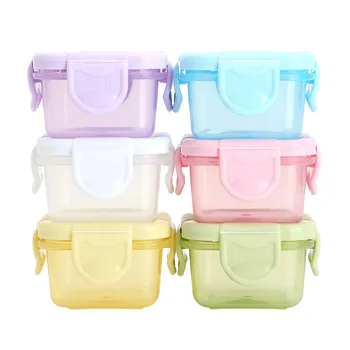
Pros/Cons
Pros
- Airtight, watertight, leak-proof seal prevents spills in freezer or diaper bag
- Stackable tray keeps containers stable and organized in the freezer
- Measurement markings make portioning simple
Cons
- Some reviewers find that taking apart 3 pieces to wash can be tiresome, but does allow for a thorough cleaning
Parent’s Review
OXO Tot Baby Blocks Freezer Storage ContainersThe quality of these containers is definitely much superior than the other cheap ones we see here on Amazon. Why buy a cheaper thing to your baby if you will be using these containers over an over again? Also they are beautiful and very easy to clean. They are so good that I decided to buy more sets, I have 2 of 4 oz containers and 2 of the 6 oz containers. For now, that my baby is 8 months old his meals are 4 oz but might improve in the future so I decided have those bigger ones and fill with whatever quantity I want now.
– Renata
Baby Blocks are airtight, watertight and leakproof for safe storage and spill-free outings.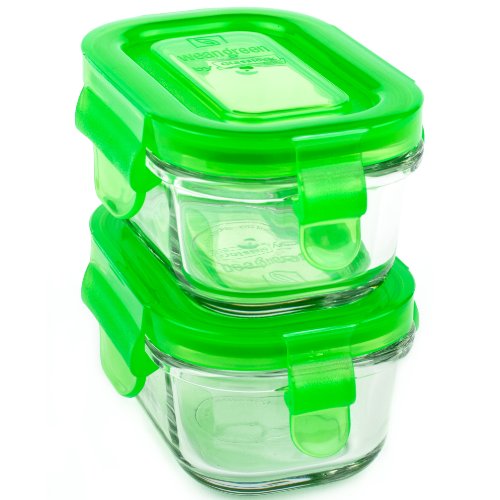 Blocks fit into the freezing tray, and multiple trays can be stacked to save space in the freezer.
Blocks fit into the freezing tray, and multiple trays can be stacked to save space in the freezer.
Amazon
Walmart
Target
Tips on Freezing and Best Containers
Learn the secrets to storing and freezing homemade baby food for ultimate freshness—AND the best baby food storage containers to use to ensure that you never waste what you make!
Baby Food Storage
Going through the effort to make homemade baby food really only works if you have a good plan for how to store the food to ensure that it stays fresh and that baby has plenty of opportunities to enjoy it. After making a LOT of baby food for my third kiddo to send with him to daycare, I got into a good routine of making and storing baby food—both in the fridge and freezer. Here’s how you can do it too.
TIP: You can find my favorite baby food recipes here.
Homemade Baby Food Storage: In the Fridge
You can store baby food in the fridge in airtight containers for up to 3 days. You can use masking tape and a Sharpie to label the containers with the contents and the date if you have a hard time keeping track of when you made something. (It’s definitely helpful to do that!)
You can use masking tape and a Sharpie to label the containers with the contents and the date if you have a hard time keeping track of when you made something. (It’s definitely helpful to do that!)
Best Baby Food Storage Containers
I have a four favorite baby food storage containers that I use regularly.
1. Wean Green Baby Food Cubes
These are small, incredibly durable, and made from glass. They’re easy to clean and last forever. (Seriously, I’ve been using the same set for 7 years and they’re still as good as new!) $19.99 for a set of 4
2. Easy Lunchboxes Mini Dippers
These small containers are a perfect size for 1-2 frozen baby food cubes and they’re my go to for packing food for a baby to take to daycare. They also nest nicely when stored in the cabinet. $7.95 for a set of 8
3. Beaba Food Storage Containers
I have two sets of these and I use them regularly for larger amounts of baby food (you could probably fit 4 cubes of frozen food) and for toddler snacks.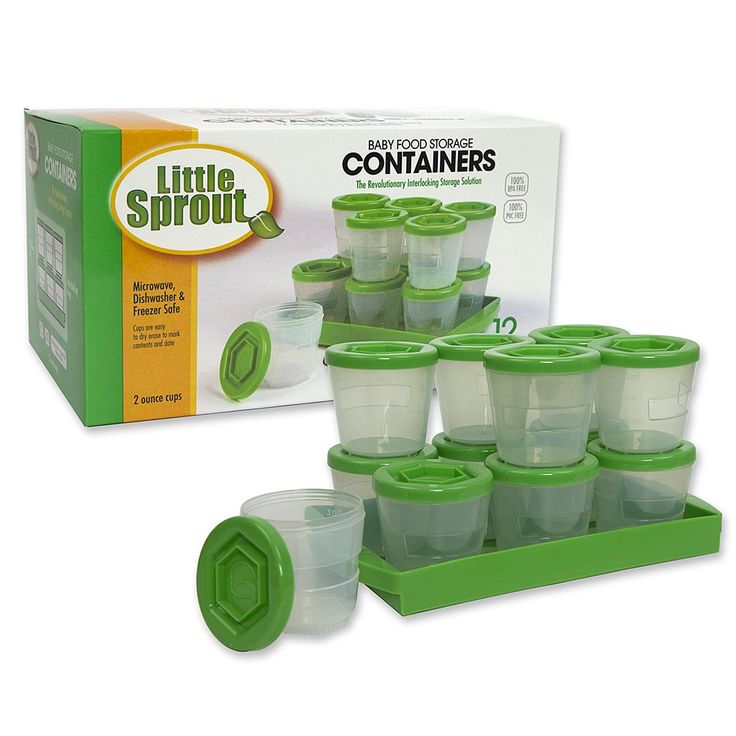 When assembled, they snap together, so they’re an easy way to stay organized. $14.95 for a set of 6
When assembled, they snap together, so they’re an easy way to stay organized. $14.95 for a set of 6
4. Oxo Tot Baby Food Blocks
This neat system is easy to keep contained in the fridge and is also made from a polypropylene body that is PVC, BPA, and phthalate free. They are dishwasher and microwave safe. $9.99 for a set of 6
Homemade Baby Food Storage: For Freezing
Storing homemade baby food in the freezer allows you to make a bigger batch at once, and then serve it to baby over the course of a few weeks or months.The easiest way is to use an ice cube tray, which has the added benefit of portioning out the baby food nicely.
TIP: Any ice cube tray will do. You can use silicone ice cube trays if you prefer a non-plastic option.
Baby Food Storage Without An Ice Cube Tray
If you don’t have an ice cube tray or you’d just rather not use one, you can place a predetermined amount of baby food into a pint-size freezer bag.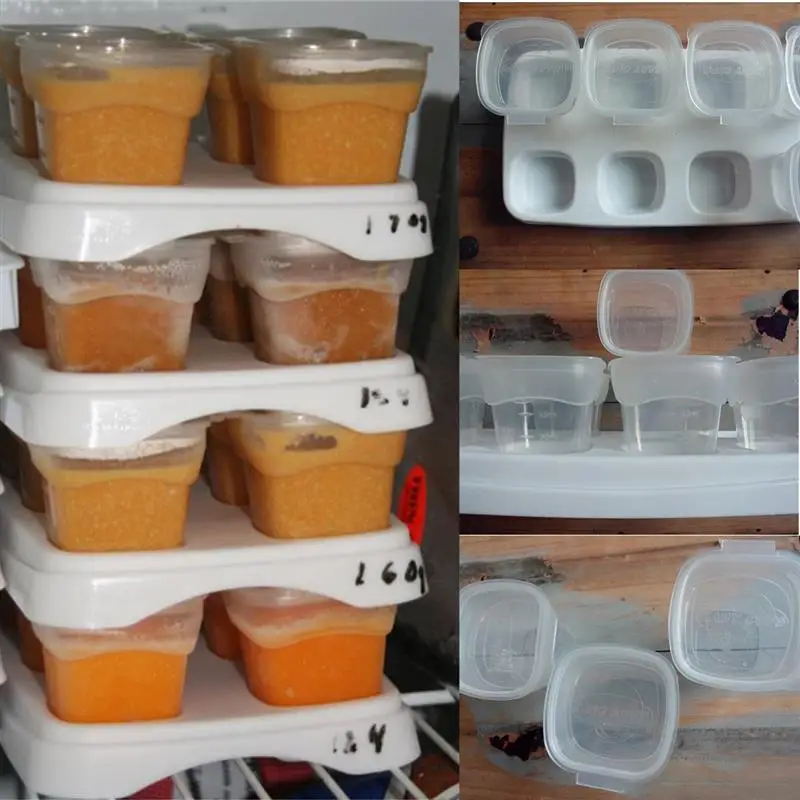 Remove as much air as possible, press flat, and seal. Place flat in the freezer to freeze. Then you can thaw the entire bag in the fridge overnight, or break off a portion of it to thaw.
Remove as much air as possible, press flat, and seal. Place flat in the freezer to freeze. Then you can thaw the entire bag in the fridge overnight, or break off a portion of it to thaw.
How to Store Baby Food in the Freezer Step by Step
- Place baby food into each compartment of the ice cube tray, or fill as many as you need to with the amount of baby food you have.
- Cover (if your ice cube tray has a cover) and freezer for 4-6 hours or overnight.
- Pop out frozen cubes and transfer to freezer storage bags. Label as desired with the type of baby food and the date.
- Store in the freezer for up to 3 months.
TIP: I like to have a bag of sweet fruit purees and more savory vegetable purees to avoid having too many separate bags in the freezer at any given time. Then you can combine them into baby food combinations easily!
How to Thaw Baby Food
To thaw baby food, simply remove a cube (or as many as you need) and place into airtight containers.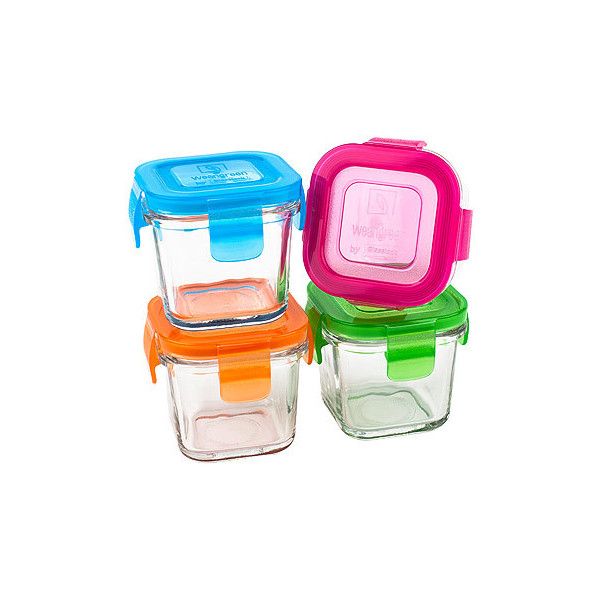 Thaw overnight in the fridge and serve. 1 cube may be plenty for a baby aged 6-7 months and older babies may enjoy two cubes.
Thaw overnight in the fridge and serve. 1 cube may be plenty for a baby aged 6-7 months and older babies may enjoy two cubes.
Tips for the Best Baby Food Storage
- Keep fresh baby food in an airtight container for up to 3 days in the fridge.
- Use a regular ice cube tray to freeze, a silicone ice cube tray with a lid, or a small freezer bag with the contents pressed flat.
- Store frozen baby food in a freezer storage bag in the freezer for up to 3 months.
- To avoid freezer burn, try to remove as much air as possible from the storage bags.
- Label your bags with the contents and the date.
- To thaw baby food, simply remove a cube (or as many as you need) and place into airtight containers. Thaw overnight in the fridge.
- Use leftover baby food to flavor yogurt, baby oatmeal, baby rice cereal, smoothies, or cottage cheese.
- See some of my favorite Baby Food Pouch recipes here for more ideas on how to serve your baby food!
I’d love to hear your feedback if you have another storage technique or container that you love, so please comment below!
Medical thermal containers for carrying vaccines.
 Cooler bag for medicines
Cooler bag for medicines O Termokonteyner.ru
Our company sells universal and most popular thermal containers. Our products will pleasantly surprise you with low prices and consistently high quality. On our website, using a convenient filter, you can quickly select and order the necessary thermal containers, as well as ice packs and other accessories for them. After you place an order, we will once again pleasantly surprise you with fast delivery.
The medical thermal container is used to ensure the optimal temperature regime during the storage and transportation of vaccines, as well as other biological preparations. Thermal containers are made of expanded polystyrene. The outer surface is protected by a cover made of durable synthetic material, the inner surface is protected by a very durable polystyrene film. A refrigerator bag is a thermal container for carrying and storing medicines. We offer cooler bags with a capacity of 2 to 50 liters.
Basic requirements for thermal containers:
- ensuring the optimal temperature inside the container during the transportation of biological products, the minimum time for maintaining the set temperature values is 8 hours;
- the presence of built-in or separately attached devices for threshold registration of fluctuations in temperature values;
- availability of special devices intended for sealing the lid of a medical thermal container;
- the presence of a reliable system of fixing parts that prevent accidental opening of the lid of the medical thermal container during transportation.
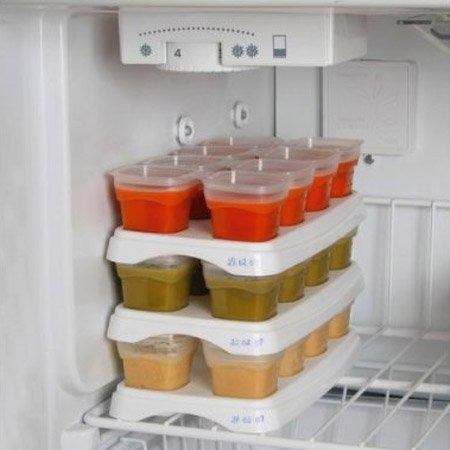
Thermal containers differ not only in external characteristics (weight, dimensions, internal volume), but also in their main operational properties, the main of which is the duration of storage of vaccines and other biological products in them.
Compact and lightweight thermal containers (TM2, TM4, TM6) with a volume of 2, 4 and 6 liters ensure that the temperature is optimal for storing vaccines for 6-12 hours. They are ideal when small quantities of biologicals need to be transported over short distances.
Medium-sized medical thermal containers (TM9, TM16) with an internal volume of 9-16 liters are distinguished by their greater weight and longer vaccine storage time - 12-18 hours. Large thermal containers (TM25, TM32, TM50) are designed to transport much larger batches of vaccines. Their volume is from 25 to 50 liters, while the period during which the normal temperature is maintained is also no more than 18 hours.
For transportation over long distances, special weighted medical thermal containers model TM9 are designed.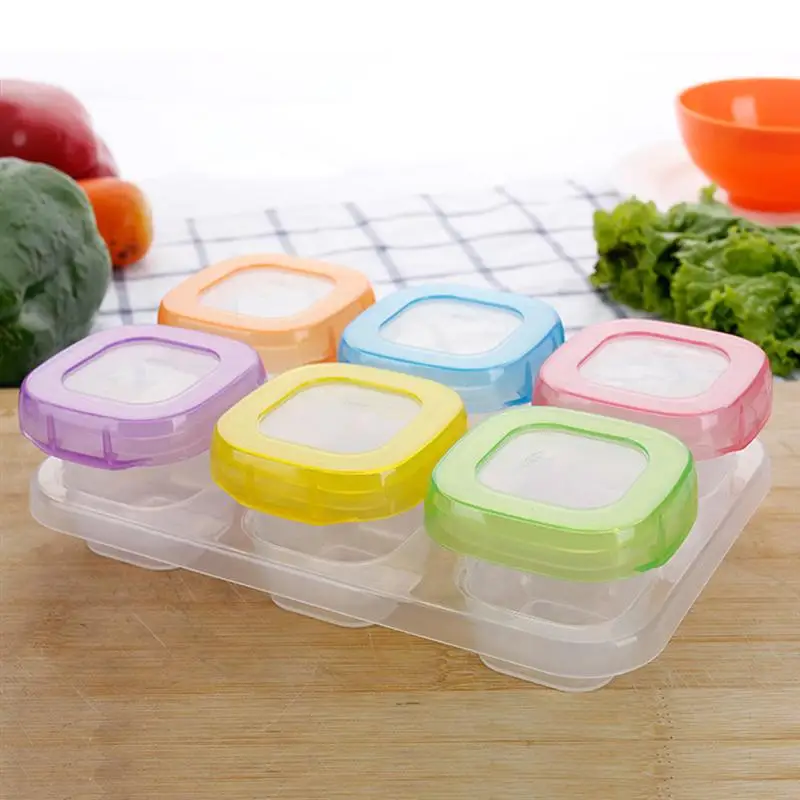 -us. Due to the thicker wall, the thermal container is able to maintain the optimum temperature for transporting biological preparations for one to three days.
-us. Due to the thicker wall, the thermal container is able to maintain the optimum temperature for transporting biological preparations for one to three days.
Baby food storage: containers, terms and regulations Article updated: May 14, 2021.
The body of a newborn baby is undoubtedly more vulnerable than adults and even children older than one year. But as long as the child is breastfed, he is more protected from aggressive environmental factors. The situation becomes more complicated when it is time for the first complementary foods. By this time, it is important for mom to learn everything about the proper storage of baby food.
Photo: depositphotos.com. Author: Petunya.
Contents
- Breast milk
- Accessories
- Avent containers
- Other sets
- Why is this important?
- Frozen foods
- Requirements
- What do you need?
- Send to freezer
- Preparation
- Shelf life
- After opening
- Dry mix
- Tips
Breastmilk
Almost all mothers who breastfeed their babies face the problem of storing it.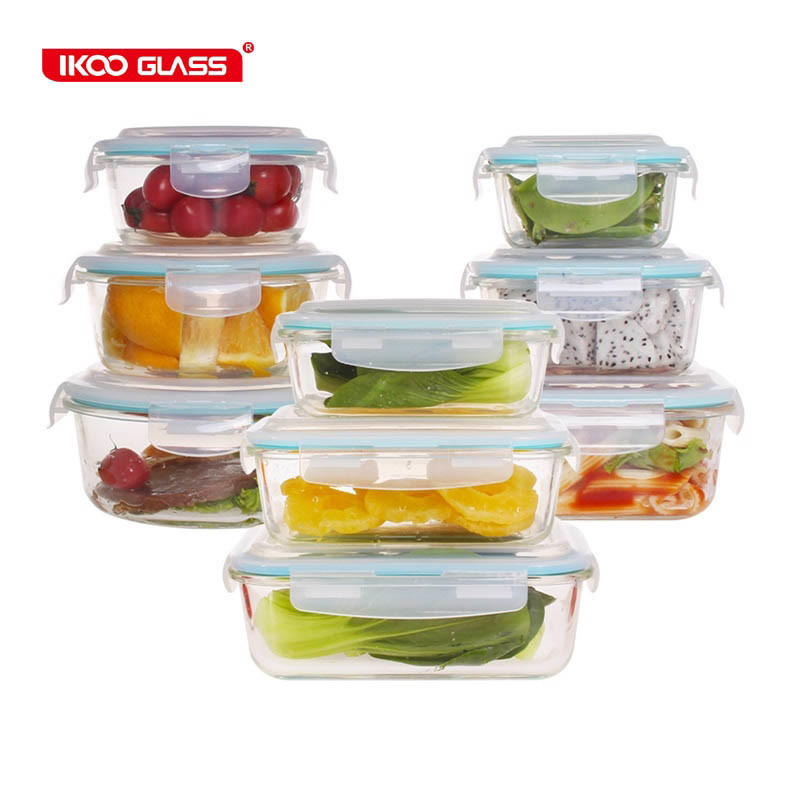 Sometimes a mother needs to be away on important matters, and therefore the responsibility to feed the baby is assigned to another family member.
Sometimes a mother needs to be away on important matters, and therefore the responsibility to feed the baby is assigned to another family member.
What you need to know about the safety of expressed milk?
- The best containers are either reusable containers or sterile disposable bags with a measuring scale, for example: Lansinoh, Medela, Dr. Brown’s or Pigeon. They can be found in specialized children's stores or pharmacies in the city.
- Milk from different pumping times must not be poured into the same container.
- If you are going to defrost milk, do not rush to heat it up. First, let the ice completely melt and only then start heating - either in a water bath or in a heater.
Accessories
Avent Containers
Philips Gourmet VIA Avent Sterilized Container Set is a convenient and thoughtful system for storing baby food, including mother's milk. Such containers can be used repeatedly, there are several of them in the set, but they should be thrown away immediately if the view becomes unusable.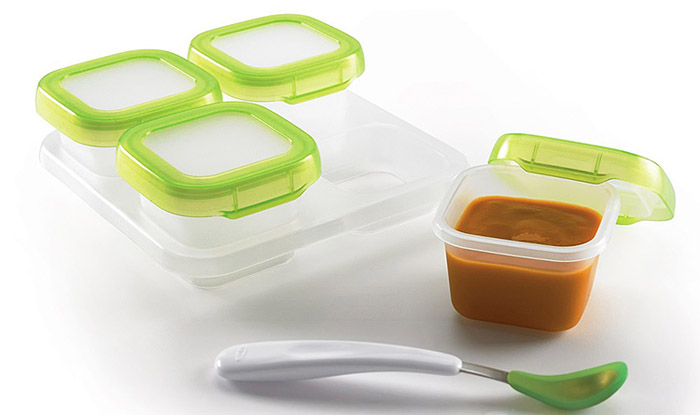
System advantages:
- is a convenient novelty for storing, transporting mother's milk/formula and feeding the baby;
- containers are easy to care for;
- due to the sterility of VIA Avent "Gourmet", there is no need to shift the contents during feeding;
- you can use the handy spoon included in the set;
- containers are quite stable and do not take up much space during storage, if desired, they can be stacked on top of each other;
- The milk preparation time is easy to write directly on the surface of the VIA Avent container.
Other sets
In addition to the undisputed market leader - the manufacturer VIA Avent, you can find containers for storing baby food of other brands:
- Babymoove (France). The main advantage is the presence of not only plastic containers, but also sets made of food grade silicone.
- BabyOno (Poland) - a line of plastic containers that do not contain bisphenol-A harmful to the child; a special spoon-shaped dispenser is built into the lid of the container.
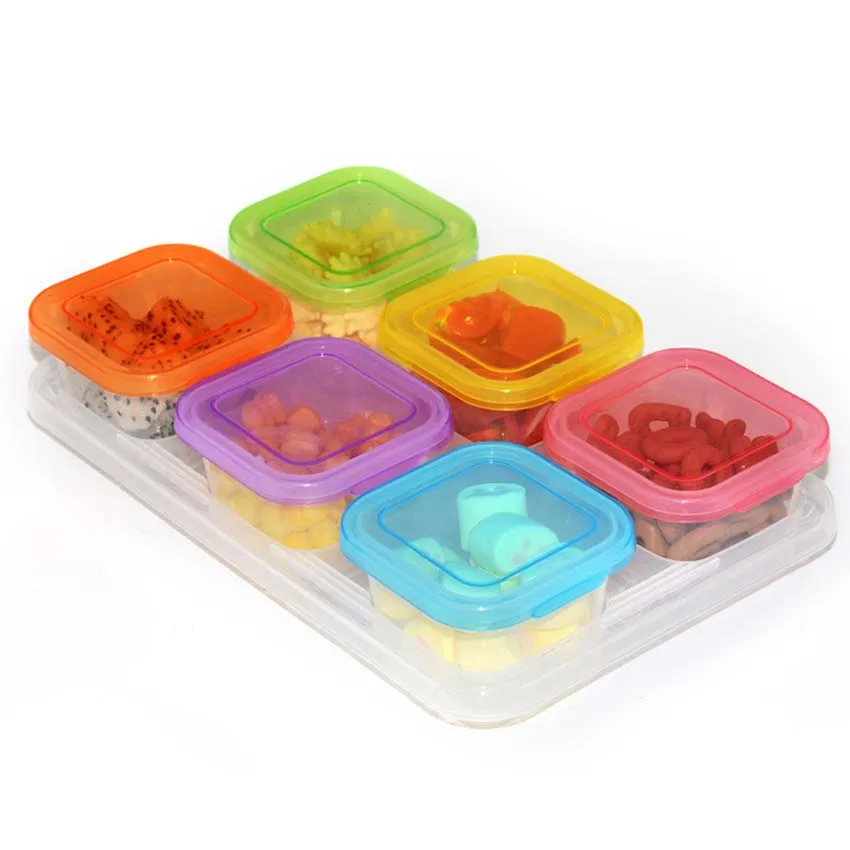 Also on sale you can find a set of magic silicone molds, a distinctive feature of which is a hermetically sealed lid with four locks, which excludes leakage.
Also on sale you can find a set of magic silicone molds, a distinctive feature of which is a hermetically sealed lid with four locks, which excludes leakage. - Beaba (France) boasts not only multi-portion silicone containers, but also special containers for cooking cereals. This is good news for parents who are starting to feed their baby with homemade cereals.
- Brother Max (UK) makes a set of cube-shaped baby food freezer containers that snap together easily.
- Infantino (USA) - their products are distinguished by a professional approach to business. Now moms and dads have the opportunity to get a real station for packaging baby food.
All modern baby food storage kits are dishwasher, freezer and microwave safe.
Why is this important?
It should not be forgotten that young children cannot eat large amounts of food at one meal. If you want to save time for activities with the child, food for him can be prepared in advance for several feedings.
If you want to save time for activities with the child, food for him can be prepared in advance for several feedings.
Until about three years old, the child's immunity is not yet fully developed, so it is difficult for him to fight viruses and microbes. In turn, good nutrition can strengthen the immune system of the crumbs. For this reason, it is so important to store baby products properly. This is especially true of frozen vegetables, fruits and berries, because in the cold season they will become an indispensable source of trace elements and vitamins.
Such preparations can be used to make wonderful healthy puree, kissels, compotes, soups and much more in winter. Ready-made dishes are served separately or become an excellent addition to cereals that are not always loved by children.
Frozen foods
Requirements
A set of basic rules for freezing foods for children:
- Use only intact vegetables or fruits.
- They can only be frozen once, so before sending them to the freezer, pack them into small portions and arrange them in bags.
 This also applies to meat.
This also applies to meat. - Frozen products retain their useful properties for no more than two months. After this period, the taste deteriorates, and the amount of vitamins and minerals contained in them drops dramatically.
- Use domestic products, and best of all - grown in your own garden. Imported vegetables and fruits are not suitable for the preparation of baby food for the future.
What do you need?
Simple ice cube trays are perfect for storing baby food. You can spread freshly prepared mashed potatoes in them, cover it with a special cling film and place it in the freezer. The main condition is a sufficiently low storage temperature.
You can also use several pre-lined baking trays. Divide cooked baby food into single servings, and distribute them evenly among trays.
Thanks to one of these techniques, in the future you will be able to separate the set of products needed for one feeding, and you will not have to deal with vegetables stuck together in a lump.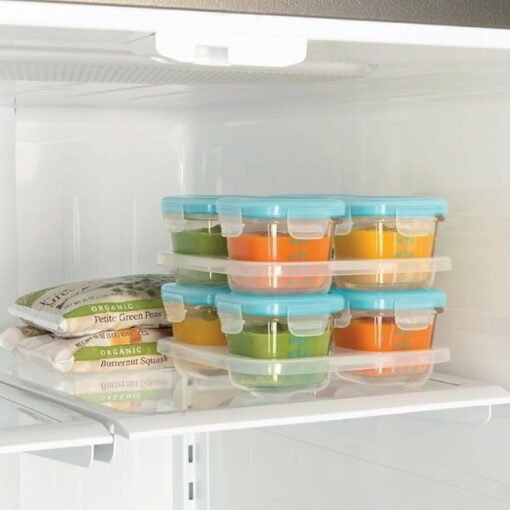
Frozen storage foil is not recommended.
Send to freezer
Your baby's food is ready, now it's time to freeze it. To do this, you first need to cool the food to room temperature.
Before sending food for the baby to the freezer, it is necessary to check it for the presence of unpleasant odors: it is necessary to exclude the possibility of freon leakage - a refrigerant gas that has a specific smell.
To prevent the growth of bacteria in food, set the temperature in the freezer to no higher than -18 degrees.
Frozen food in molds can be transferred to cellophane, releasing all the air from it. Each package should be signed, indicating the date of preparation. In this form, products can be stored for no longer than two weeks.
Preparation
To prepare frozen puree, it must first be thawed properly. To do this, take the amount of food that the child can eat at one time. There are several options:
- Move the puree from the freezer to the refrigerator, after a while the product will melt itself.

- Transfer the portion to an enamel bowl and place over low heat. Here you need to make sure that the product does not burn.
- Another option that modern mothers often use is defrosting in a microwave oven. Although the safety of this method raises doubts among some experts.
Never thaw baby food at room temperature. This causes the reproduction of microorganisms in the products that can harm the child.
In the first and third cases, the nutrition pack must not be opened until the contents have completely thawed.
Shelf life
As soon as you open any baby food, its shelf life is significantly reduced. So, milk adapted mixtures or cereals should be stored in the open for no more than three weeks. If we are talking about fermented milk products, then they can be stored exclusively in the refrigerator, and they should be on a separate shelf.
Milk, kefir, cottage cheese and yogurt are kept open for no more than a day, otherwise you can poison your baby.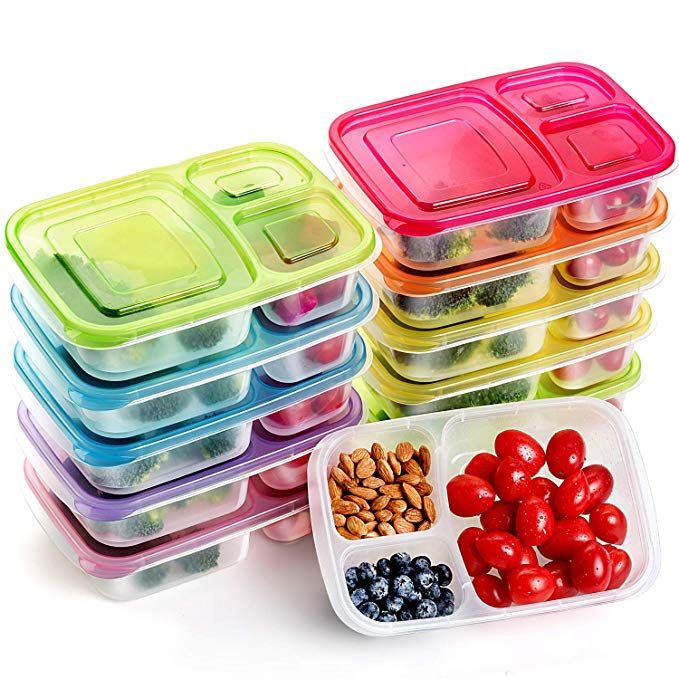 Before you give your baby fermented milk products from the refrigerator, be sure to try it yourself first. This will help you personally make sure that the products are not sour. If milk turns sour before a full day, your refrigerator may be faulty or the temperature is incorrectly set.
Before you give your baby fermented milk products from the refrigerator, be sure to try it yourself first. This will help you personally make sure that the products are not sour. If milk turns sour before a full day, your refrigerator may be faulty or the temperature is incorrectly set.
If you prepare food for your child yourself, it is generally not recommended to store it. Homemade cereals or already diluted mixtures will only be suitable for two hours from the moment of preparation, vegetable or fruit puree will quickly darken, and the juices will begin to oxidize. What your baby did not eat on time should either be thrown away or eaten by yourself.
After opening
Most baby purees rapidly lose their useful properties after opening. In addition, the expiration dates are not always found on jars. For children, intestinal infections are very dangerous, and therefore open mashed potatoes should not be stored for more than two days.
A lot also depends on the refrigerator: one freezes more, the other less.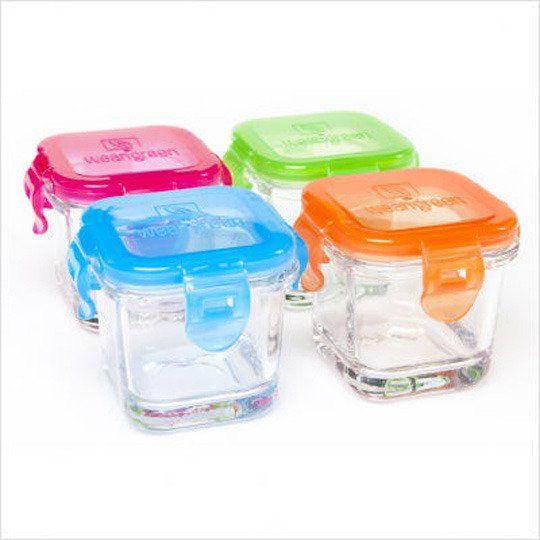 Never put baby food in the refrigerator door, it is better to place it on the top shelf.
Never put baby food in the refrigerator door, it is better to place it on the top shelf.
Please note: if you preheat the jar, the shelf life of the product in it will be greatly reduced compared to the data on the label.
The shelf life also depends on the room temperature. If it is +20 degrees or more, then the product is suitable for only 5-6 hours.
Dry sweep
The safe storage time for infant formula is clearly stated on the packaging. As soon as the pack is opened, the period of use will be reduced significantly. The fact is that dangerous microorganisms quickly develop in a dry powder. Keep an open pack in the refrigerator, and prepare the product itself immediately before feeding. It is not necessary to breed more than the baby will eat at one time. When traveling, place the bottle of formula in a thermos for baby bottles or a cooler bag. In this case, baby food will remain fresh for some time.
Tips
- Before buying any product, you should study all information contained on its packaging from the manufacturer.
 Pay attention to the production time - suddenly the jar stood in the warehouse for a long time.
Pay attention to the production time - suddenly the jar stood in the warehouse for a long time. - Baby food spoils rather quickly after opening and should not be refrigerated for more than two days. If necessary, heat up the portion calculated for one dose, and not the whole jar, otherwise its shelf life will be reduced to one day.
- The maximum recommended storage temperature for sealed jars of baby puree is 12 degrees, and when opened it is only 4 degrees (standard refrigerator temperature). The shelf life of open products without a refrigerator is reduced to 6 hours at temperatures below 20 degrees and, accordingly, 4 hours at higher air temperatures.
- If you have any doubts about the quality, throw the yoghurt or puree into the waste bin immediately. There is no shortage of baby food in stores, it will always be possible to buy more, and the health of the baby is much more valuable than a few jars thrown away.
- It is unlikely that you will be able to know for sure how the food was stored in the warehouse.


